The AMD Radeon R9 295X2 Review
by Ryan Smith on April 8, 2014 8:00 AM EST- Posted in
- GPUs
- AMD
- Radeon
- Radeon 200
Compute
Our final set of performance benchmarks is compute performance, which for dual-GPU cards is always a mixed bag. Unlike gaming where the somewhat genericized AFR process is applicable to most games, when it comes to compute the ability for a program to make good use of multiple GPUs lies solely in the hands of the program’s authors and the algorithms they use.
At the same time while we’re covering compute performance for completeness, the high price and unconventional cooling apparatus for the 295X2 is likely to deter most serious compute users.
In any case, our first compute benchmark is LuxMark2.0, the official benchmark of SmallLuxGPU 2.0. SmallLuxGPU is an OpenCL accelerated ray tracer that is part of the larger LuxRender suite. Ray tracing has become a stronghold for GPUs in recent years as ray tracing maps well to GPU pipelines, allowing artists to render scenes much more quickly than with CPUs alone.
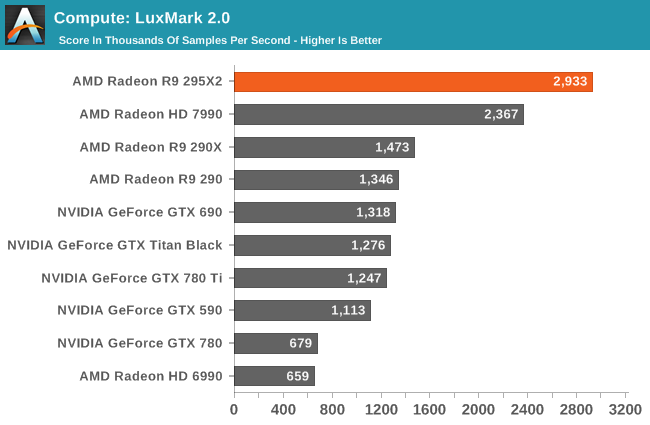
As one of the few compute tasks that’s generally multi-GPU friendly, ray tracing is going to be the best case scenario for compute performance for the 295X2. Under LuxMark AMD sees virtually perfect scaling, with the 295X2 nearly doubling the 290X’s performance under this benchmark. No other single card is currently capable of catching up to the 295X2 in this case.
Our second compute benchmark is Sony Vegas Pro 12, an OpenGL and OpenCL video editing and authoring package. Vegas can use GPUs in a few different ways, the primary uses being to accelerate the video effects and compositing process itself, and in the video encoding step. With video encoding being increasingly offloaded to dedicated DSPs these days we’re focusing on the editing and compositing process, rendering to a low CPU overhead format (XDCAM EX). This specific test comes from Sony, and measures how long it takes to render a video.
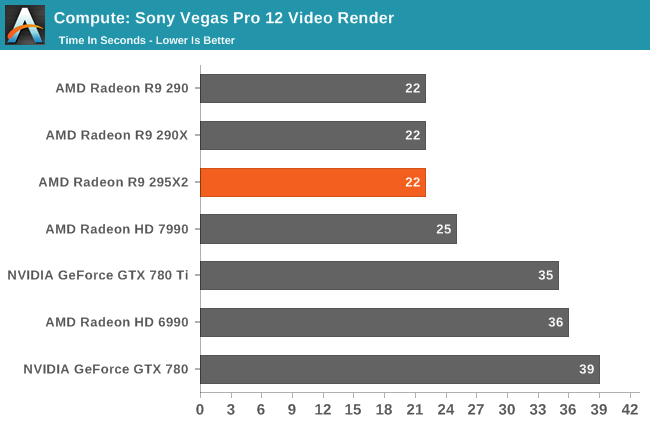
Sony Vegas Pro on the other hand sees no advantage from multiple GPUs. The 295X2 does just as well as the other Hawaii cards at 22 seconds, sharing the top of the chart, but the second GPU goes unused.
Our third benchmark set comes from CLBenchmark 1.1. CLBenchmark contains a number of subtests; we’re focusing on the most practical of them, the computer vision test and the fluid simulation test. The former being a useful proxy for computer imaging tasks where systems are required to parse images and identify features (e.g. humans), while fluid simulations are common in professional graphics work and games alike.
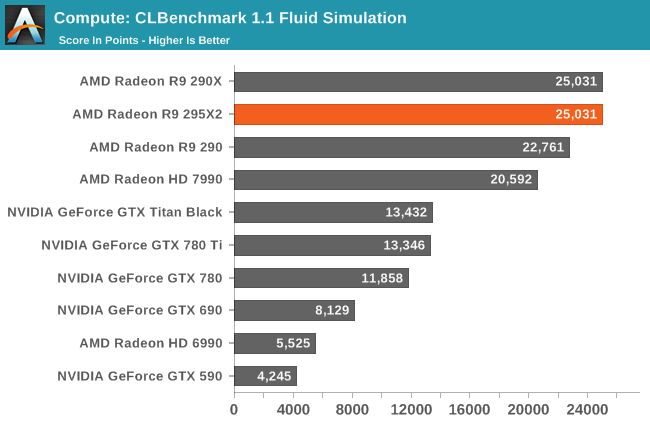

Like Vegas Pro, the CLBenchmark sub-tests we use here don't scale with additional GPUs. So the 295X2 can only match the performance of the 290X on these benchmarks.
Moving on, our fouth compute benchmark is FAHBench, the official Folding @ Home benchmark. Folding @ Home is the popular Stanford-backed research and distributed computing initiative that has work distributed to millions of volunteer computers over the internet, each of which is responsible for a tiny slice of a protein folding simulation. FAHBench can test both single precision and double precision floating point performance, with single precision being the most useful metric for most consumer cards due to their low double precision performance. Each precision has two modes, explicit and implicit, the difference being whether water atoms are included in the simulation, which adds quite a bit of work and overhead. This is another OpenCL test, as Folding @ Home has moved exclusively to OpenCL this year with FAHCore 17.
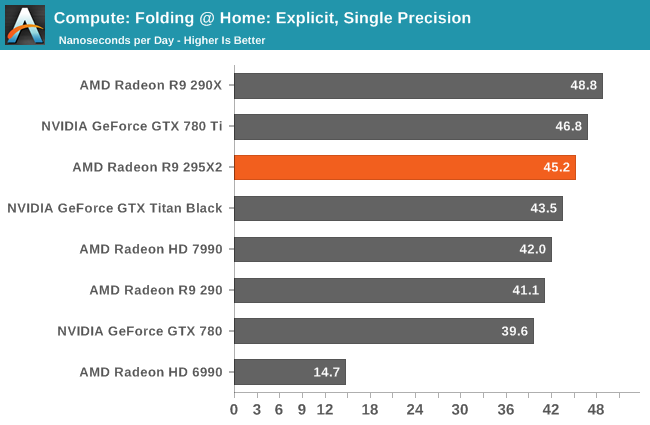
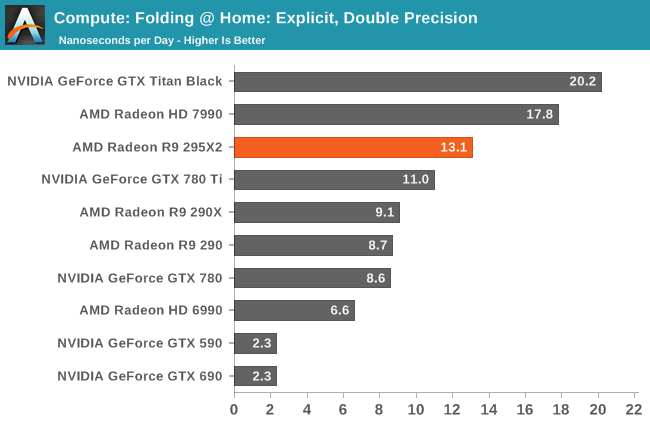
Unlike most of our compute benchmarks, Folding@Home does see some degree of multi-GPU scaling. However the outcome is really a mixed bag; single-precision performance ends up being a wash (if not a slight regression) while double-precision is seeing sub-50% scaling.
Wrapping things up, our final compute benchmark is an in-house project developed by our very own Dr. Ian Cutress. SystemCompute is our first C++ AMP benchmark, utilizing Microsoft’s simple C++ extensions to allow the easy use of GPU computing in C++ programs. SystemCompute in turn is a collection of benchmarks for several different fundamental compute algorithms, as described in this previous article, with the final score represented in points. DirectCompute is the compute backend for C++ AMP on Windows, so this forms our other DirectCompute test.
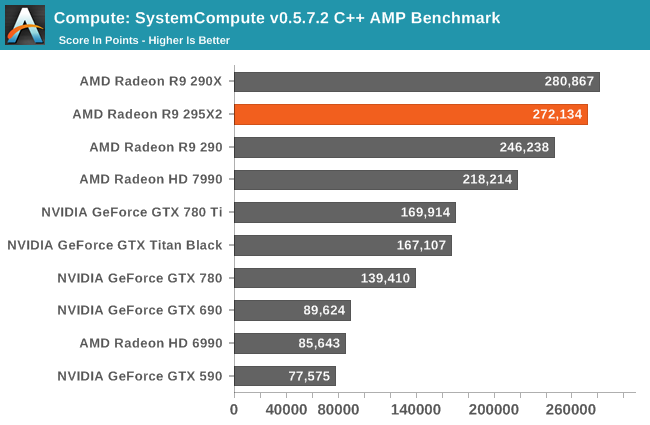
Our final compute benchmark has the 295X2 and 290X virtually tied once again, as this is another benchmark that doesn’t scale up with multiple GPUs.










131 Comments
View All Comments
Samus - Tuesday, April 8, 2014 - link
Very pretty cooler.slickr - Tuesday, April 8, 2014 - link
Is it me or is pricing on graphic cards INSANE? $1500 for this and then $3000 for Titan Z? I mean give me a break, I'd buy a freaking car with that money.stefpats - Tuesday, April 8, 2014 - link
my question is: is there going to be a GTX 790 or that plan is gone? i would like to compare similar things,and then decide what i m replacing 690 with.I ve waited long enough it's time for an upgrade.TheinsanegamerN - Friday, April 11, 2014 - link
My guess, no. They will have the 890, skipping over the 790 completely. 20nm and maxwell will make for a much more interesting dual GPUekagori - Tuesday, April 8, 2014 - link
I like what AMD has done here, paying more attention to the high end packaging is good to see. Hopefully this trickles down to the next generation on 20nm. Considering how far AMD has been behind NVidia in terms of power consumption, seeing this card average under 500W at full load is pretty good. That's under 250W per chip, pretty close to what a 780ti does. You pay a slight premium for the better case and clc and still better than what NVidia wants for the Z.HammerStrike - Tuesday, April 8, 2014 - link
Shame there is still no HDMI 2.0 support on any consumer GPU's, including this one. Given that this is arround $250 more then two custom cooled 290X's with similar noise profiles it doesn't make much sense (at least to me) in standard or full size cases, but would be an interesting choice for a HTPC. Card is overkill for 1080p, but with new 4K TV's coming out that support HDMI 2.0 this would have made sense for that. As it is, while I can appreciate the design and performance, I don't see the value prop vs a couple of individual 290x's in CF.TinHat - Friday, April 11, 2014 - link
Can you not just use Displayport like everyone else? I believe its got far superior resolution support and because its loyalty free to produce, its cheaper too!Camel51 - Wednesday, April 9, 2014 - link
What is the static pressure of the 120mm fan? Is it easily replaceable? I'm wondering if it would make sense to replace it with an SP120 HP edition, a Noctua, or any other high static pressure/low noise fan (even if it would require modding it in by cutting wires).The review was excellent. Very informative and interesting. Took me a whole hour to read. Haha. I just wish the card was short enough to fit in the Obsidian 250D. Now for the Ares III!
Ryan Smith - Wednesday, April 9, 2014 - link
I don't have any information on the static pressure, but the fan is easily replaceable. It's just a standard 120mm fan; so any other 2pin/3pin 120mm fan should work.henrikfm - Wednesday, April 9, 2014 - link
Does it make coffee?